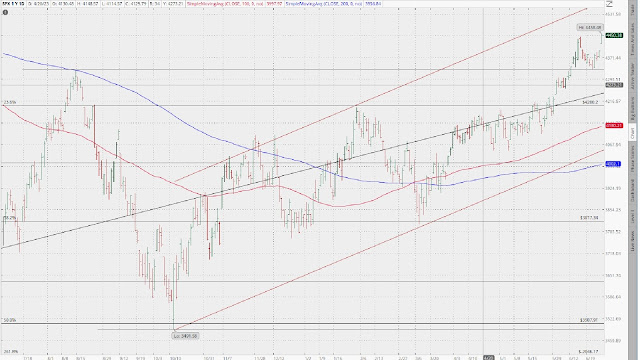The Morning Call
7/3/23
I am on vacation but
wanted to get last week’s summary out. I will remain on vacation through the 10th.
The
Market
Technical
I opined in last
week’s Monday Morning Chartology that our task now was to ‘sit back and see
where the index can find support.’ Well,
it found support all right. After a down Monday, stocks were off to the races
culminating in a huge gap up open on Friday that marked a new higher high in
the current short-term uptrend. And in the process, it called into serious
question the whole negative sentiment/positioning narrative. Clearly, the trend
remains positive; though that gap up open needs to be filled.
TLT had an
interesting week. I say interesting because I can’t make a lot of sense out of
its pin action. It started the week challenging both DMAs, took a severe tumble
on Thursday (creating a major gap down open), then immediately reversed itself,
moving higher and closing the gap open.
Unlike stocks and
bonds, GLD maintained its current short-term trend---to the downside. However, ‘it
remains in intermediate and long-term uptrends. Nevertheless, support is a long
way away; so, there is lots of room for more downside before any real technical
damage is done.’
The dollar continued its very short-term trend to the upside. Like GLD, no erratic reversals here. It did touch its 200 DMA (now resistance) and backed off. Let’s see if it tries again. Not much information to be gleaned from this chart; though the stability in GLD and UUP contrasts sharply with the volatility (speculation?) in both stocks and bonds and suggests the need for caution.
Friday in the
charts.
Fundamental
Headlines
The
Economy
Last Week Review
Last
week’s US stats were overwhelmingly positive (five plus primary indicators, one
negative). Overseas, the data was downbeat but just so. It is becoming increasingly
clear that the rest of the global economy is slowing if not in recession---certainly,
Europe is.
On
the other hand, after a couple of weeks of disappointing US numbers, last week provided
max cognitive dissonance. As you know, I have a US recession in my forecast;
but based on over a month’s worth of upbeat stats, I was seriously considering
reversing that call. Then came a couple of weeks of disappointing numbers which
revived my confidence that a recession was in the offing. And now this. So,
color me confused. I am not giving up on the recession outlook; but once again
my faith in that forecast is being shaken.
The
other issue investors must deal with is, of course, inflation. And perhaps more
importantly, how the Fed perceives this problem and even more important, just
how firm is its determination to achieve its 2% target. We got more direction
this week from Powell who spoke at an international conference---in which he
reiterated that inflation remains a major concern and therefore, more rate
hikes were likely on the table.
That
said, as you know, I am quite skeptical of the Fed’s forecasting expertise---though
clearly last week’s data support the Fed’s hawkish stance---and have even less confidence
in its courage to maintain a restrictive monetary policy in the face of even
the slightest hint of economic/Market turmoil.
So,
despite Powell’s rhetoric, I have no great expectations that the Fed will stick
to its guns in pushing inflation back to 2%. Indeed, I believe that the only
way inflation gets back to 2% is on the back of a painful recession. To be
clear, I have no idea if we will have a painful recession.
Longer
term, irrespective of how low inflation goes in the short term, irrespective of
whether or not we have a recession and if so, how deep it will be, we are still
faced with an economy growing at well below its historic secular rate and a
base rate of inflation above 2%.
Regrettably, years of fiscal profligacy have left us with a debt to GDP
ratio far in excess of the boundary marked by Rogoff and Reinhart as the level
at which the servicing of too much debt negatively impacts the growth rate of
the economy. And years of irresponsible monetary expansion have led to the
misallocation of resources and the mispricing of risk.
Correcting those self-inflicted wounds won’t be easy. It will take years
of fiscal and monetary restraint to do so. And that would mean less fiscal
stimulus and interest rates staying higher for longer than many now expect---which
unfortunately is not apt to happen.
The
Economy
US
International
Other
News on Stocks in Our Portfolios
What
I am reading today
******************************************************************************
Visit Investing
for Survival’s website (http://investingforsurvival.com/home)
to learn more about our Investment Strategy, Prices Disciplines and Subscriber
Service.





No comments:
Post a Comment